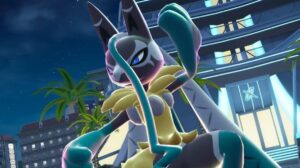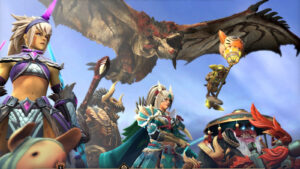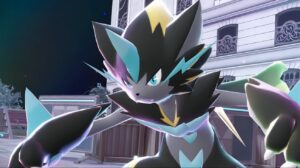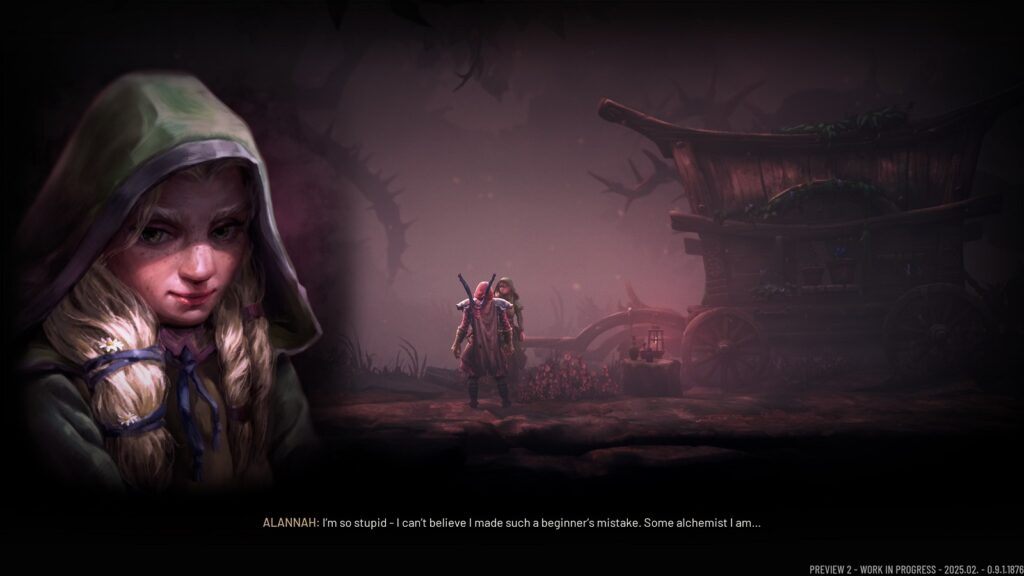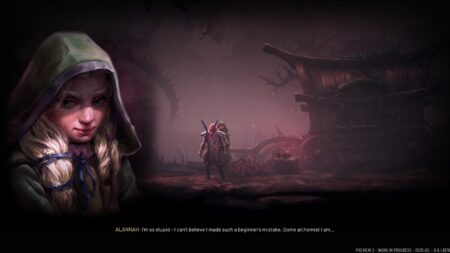Mandragora Whispers of the Witch Tree is a 2.5D side-scroller ARPG with Metroidvania and Soulslike elements. It tells the story of an Inquisitor sent on a mission to hunt down a witch suspected of crimes against the Holy City. While the themes and genre of the game are nothing new, Mandragora, at least from my initial impressions, appears to possess deep RPG mechanics and a vibrant hand-painted art style that not many games can pull off.
First things first, the playtest provided to us is the “Game Preview 2.” It has the previously locked Nightshade class and supposedly has more content. After playing the demo for more than 10 hours, here are my thoughts on how the game is shaping up so far.
As stated earlier, I chose to play the Nightshade class for this run. The class itself is different from the Vanguard and the Spellbinder classes that were part of previous demos. Since it doesn’t have immediate access to shields, the class relies on quick dodge rolls and positioning to make it through encounters. The poison status effect also plays a significant part in its playstyle. The constant damage ticks came in clutch on more than one occasion.
With that being said, stamina management seems to be this class’s Achilles Heel as much as it is its strength, especially in the early game where I can’t afford to put points in attack since constant DPS and dodging is the only way for this class to succeed up until you have more options after reaching level 25.
One of the things I focused on more in this playthrough was empowering my companions. I had previously taken for granted the upgraded armor the blacksmith can craft as well as the sharpening stones I used to keep my knives sharp. In previous playthroughs, I relied entirely on the tower shields and brute strength to get past most enemies. This time around, damage was something I couldn’t afford to take as I explored the various locations leading up to the moselium.
I was using up more consumables in this playthrough as well. This was especially so after I found Alannah and asked her to join us at the Witch Tree. I was buying up haste potions, allowing me to run circles around larger enemies. It almost felt unfair at times, getting so many hits on the Forest Giant while dodging like it was nothing.
Looking back, it was the gorgeous art style that first drew my attention to this game ever since it was known solely as Mandragora. That feeling of awe has not died down after playing both versions of the game’s demo. This is what probably pushed me to explore every known area of the playable map.
The striking and sombre remains of Western Wickham are a stark contrast to the bright and colorful forests that lie to its East. I wish I could say the same thing about the swamp, but I remember being too busy trying to through it as quickly as possible without succumbing to some undead horror.
The best part of the playtest has got to be the Fang Executioner optional boss fight in Western Wickham. When I first stumbled upon this fight, I expected a difficult fight against a fast-moving enemy. Little did I know this foe is not only fast but is also capable of creating blood shadows that mimic its previous attack.
I have to say, the Fang Executioner fight pushed me to the limit several times. Dodging the first phase was easy enough. But as soon as the blood clone appeared, I really had no choice but to change my approach: I became more cautious. I stopped trying to counterattack after every swipe as the clone was always one step back, and its damage output was no joke. There was no break in the action as long as the clone was still there.
So I waited for the clone to disappear before launching an all-out assault. I had hoped that my poison would deal more damage over time, but there’s no way for me to play it safe. Eventually, the werewolf was gonna cause me to bleed. Whenever the clone was not there, aggression was the name of the game.
It took observation and patience, but I was able to take down the Executioner shortly after discovering that the clone disappeared after a while. I look forward to more fights like this one when the game releases.
If there’s one thing that annoyed me during my time in the playtest was having to fight the same “Corrupted Vermin” miniboss no less than half a dozen times. Or at least it felt like that way. I wish there was more variety in the miniboss encounters. Would it be asking too much to encounter the Wraith again outside Pepper’s childhood home? I don’t know. In any case, I hope there will be more in terms of enemy miniboss variety. As much as I like the occasional easy win, I was seeing way too many rat bosses.
Another issue I have is making mission-critical items too hard to find and figure out. At the end of the demo, I was asked to look for a device to help me dig to the lower levels of the Moselium. I never found the item. I looked all over the map to see if I had missed something but no matter how hard I looked, it never appeared. This is nothing new in Metroidvanias. It’s humbling, to say the least. I just hope that the objectives are made clearer. Like having the witch’s voice give out a hint that leads to a certain place. Not just a vague suggestion for a grappling hook I don’t even have yet.
Mandragora: The Whispers of the Witch Tree is shaping up to be a solid ARPG. It remains to be seen if it will transcend the ranks and become a great and memorable title. Only time will tell after release. However, I am certain that Souls-like and Metroidvania fans will love this game, regardless. I can’t wait to see what the full game has to offer.
Mandragora is set to release on April 17, 2025, on PS5, Xbox Series, Nintendo Switch, and PC (via Steam).
